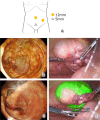Visualization of cecal tumor by near-infrared laparoscopy and intraoperative colonoscopy
- PMID: 38951358
- PMCID: PMC11217229
- DOI: 10.1186/s40792-024-01964-0
Visualization of cecal tumor by near-infrared laparoscopy and intraoperative colonoscopy
Abstract
Background: In laparoscopic colorectal surgery, accurate localization of a tumor is essential for ensuring an adequate ablative margin. Therefore, a new method, near-infrared laparoscopy combined with intraoperative colonoscopy, was developed for visualizing the contour of a cecal tumor from outside of the bowel. The method was used after it was verified on a model that employed a silicone tube.
Case presentation: The patient was a 77-year-old man with a cecal tumor near the appendiceal orifice. Laparoscopy was used to clamp of the terminal ileum, and a colonoscope was then inserted through the anus to the cecum. The laparoscope in the normal light mode could not be used to identify the cecal tumor. However, a laparoscope in the near-infrared ray mode could clearly visualize the contour of the cecal tumor from outside of the bowel, and the tumor could be safely resected by a stapler. The histopathological diagnosis of the resected specimen was adenocarcinoma with an invasion depth of M and a clear negative margin.
Conclusions: This is the first report of the laparoscopic detection of the contour of a cecal tumor from outside the bowel. This technique is useful and safe for contouring tumors in laparoscopic colorectal surgery and can be used in various surgeries that combine endoscopy and laparoscopy.
Keywords: Cecal tumor; Colonoscopy; Laparoscopic surgery; Near-infrared ray.
© 2024. The Author(s).
Conflict of interest statement
The authors declare that they have no competing interests.
Figures




References
-
- Oka S, Tanaka S, Kajiwara Y, Saito S, Fukunaga Y, Takamatsu M, et al. Treatment decision for locally resected T1 colorectal carcinoma-verification of the Japanese Guideline Criteria for additional surgery based on long-term clinical outcomes. Am J Gastroenterol. 2024 doi: 10.14309/ajg.0000000000002715. - DOI - PMC - PubMed
-
- Detering R, Rutgers MLW, Bemelman WA, Hompes R, Tanis PJ. Prognostic importance of circumferential resection margin in the era of evolving surgical and multidisciplinary treatment of rectal cancer: a systematic review and meta-analysis. Surgery. 2021;170:412–431. doi: 10.1016/j.surg.2021.02.029. - DOI - PubMed
LinkOut - more resources
Full Text Sources

